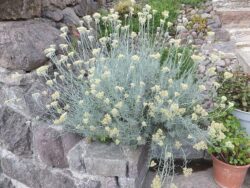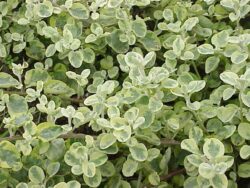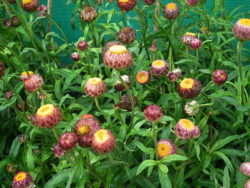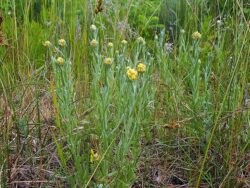In this article, we will be discussing how to grow Helichrysum in containers. Helichrysums are either an annual, evergreen perennial or shrub. They are small plants growing anywhere between 10cm to 50cm high depending on the species and varieties grown. Some are grown for their flowers, whilst others are grown for the silvery-grey leaves that they produce (such as Helichrysum petiolare).

The ones grown for their flowers tend to produce long-lasting blooms that are paper-like and come in vibrant oranges, yellows, reds or whites. They can be bicoloured as well.
The ones familiar to gardeners in the UK is Helichrysum petiolare (Liquorice Plant) or Helichrysum italicum (Curry Plant). Helichrysum bracteatum has another name of immortelle or because the flowers are delicate as Strawflowers or paper flowers. This has now been reclassed as Xerochrysum bracteatum. No matter your preference, it is a colourful plant to give you colour from summer to first frosts.
GROWING HELICHRYSUM IN CONTAINERS
You have a choice as to how you want to grow Helichrysum, either from seed or from shop-bought garden-ready plants, In general, it is better to grow annual Helichrysum from seed and buy perennial or shrub Helichrysum as garden-ready plants.
GROWING HELICHRYSUM FROM SEED

Six to eight weeks before the last frosts in spring, you can start to grow your annual Helichrysum seeds indoors. First, fill a seed tray with seed sowing compost and water well until the compost is moist. Lightly sprinkle the seeds on top of the compost thinly and then cover them with a thin layer of sieved seed compost. Place a propagator lid on top of the seed tray and place it on a heat mat or in a heated propagator.
After one to three weeks, the seeds will start to germinate and once they are large enough to handle, you can prick them out and place them in a 15 cell pack full of multipurpose compost. In late May, you can harden them off before planting them outside. For small varieties, you can plant 20cm apart, whilst 40cm is recommended for larger species.
PLANTING HELICHRYSUM IN CONTAINERS
At this stage, home-reared plants and shop-bought plants can be treated in exactly the same way.
First, choose containers that will be in proportions with the plants in question, No matter what you choose but make sure it has plenty of drainage holes. Fill the container with a good quality multipurpose compost and dig a hole slightly larger than the root ball it came in. Place the plant in, making sure the top of the root ball is at the same level as the top surface of the compost. Firm the plant in and water well.
Once established the plant will tolerate droughts very well but it is best to water when 5cm below the top of the surface of the compost feels dry to the touch.
They prefer to be grown in a sunny location but in general, they do not require much looking after.
As it can tolerate poor soil, you do not need to fertilize often unless the plant is obviously struggling (you can read my article on nutrients that plants require to help you in this regard). If you are growing perennials, you may need to give them an annual dressing with a slow-release fertiliser to give them a boost throughout the growing season.
Another task that must be performed regularly is to deadhead as this will keep the plant in bloom longer.
PESTS AND DISEASES

In general, Helichrysums tend to be pests and diseases free but they do not like their roots to be in constant moisture or in temperatures that are too cool.
They can suffer from downy mildew. Good ventilation and food distance between plants will stop the downy mildew from taking place in the first instances.
They can suffer from verticillium wilt that causes the leaves to wilt suddenly and without warning. Best to remove all affected leaves but if it is too bad the whole plant will need to come up. Do not plant in that affected compost anymore.
Aphids can attack them but it is not common. Best dealt with by spraying with jets of water or if it is very bad with a systemic insecticide/,
VARIETIES TO GROW

Helichrysum petiolare (Liquorice Plant) is the plant to grow in large containers and in hanging baskets. It has a distinct liquorice smell and hence its common name. This tender perennial sub-shrub has a trailing nature, where the leaves are oval in shape and they can be variegated silver-grey or golden. In summer, it produces tiny yellow or cream flowers that add to its appeal. It will not survive frosts but you can cut it back hard and overwinter the plant in a frost-free greenhouse. Will root very easily from cuttings taken in late summer.
Helichrysum bracleatum (now renamed Xerochrysum). Strawflower is the common annual to grow, where many named varieties exist. The flowers come in shades of orange, white yellow and red and are long-lasting. If you want larger blooms then you will need to remove any other flower buds apart from one on each stem. Fewer blooms but more impact.

Helichrysum italicum (Curry Plant) is another evergreen sub-shrub, where in May and June it is covered with attractive yellow flowers. It gets its common name because its leaves smell like curry, where it will bring a much welcome scent to the container garden. It has a lot of medicinal properties.
Helichrysum arenarium is a hardy, dwarf perennial of the genus, only growing up to 30cm high. The plant has elliptical leaves at the bottom that turn increasingly linearly towards the top. In summer, yellow flowers are produced that complete the look. An easy plant to look after.
CONCLUSIONS
In this article, we have discussed how to grow Helichrysum in containers. They are a versatile group, covering annuals, perennials, sub-shrubs and shrubs They do not only provide colour with the leaves that they produce, but the flowers the annuals produce and the scents produced by the sub-shrubs, complete the plants.
They tend to be easy to grow taking a lot of neglect, so if you want a plant in containers, then this is one for you.
If you have any questions or comments then please do so in the comment box below.
Happy Helichrysum growing.
